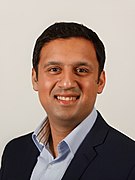This article may require copy editing for grammar, style, cohesion, tone, or spelling. (March 2024) |
| |||||||||||||||||||||||||||||||||||||||||||||||||||||||||||||||||||||||||||||||||||||||||||||||||||||||
All 129 seats to the Scottish Parliament 65 seats needed for a majority | |||||||||||||||||||||||||||||||||||||||||||||||||||||||||||||||||||||||||||||||||||||||||||||||||||||||
|---|---|---|---|---|---|---|---|---|---|---|---|---|---|---|---|---|---|---|---|---|---|---|---|---|---|---|---|---|---|---|---|---|---|---|---|---|---|---|---|---|---|---|---|---|---|---|---|---|---|---|---|---|---|---|---|---|---|---|---|---|---|---|---|---|---|---|---|---|---|---|---|---|---|---|---|---|---|---|---|---|---|---|---|---|---|---|---|---|---|---|---|---|---|---|---|---|---|---|---|---|---|---|---|
| Opinion polls | |||||||||||||||||||||||||||||||||||||||||||||||||||||||||||||||||||||||||||||||||||||||||||||||||||||||
| Turnout | Constituency – 63.5% Regional – 63.5% | ||||||||||||||||||||||||||||||||||||||||||||||||||||||||||||||||||||||||||||||||||||||||||||||||||||||
| |||||||||||||||||||||||||||||||||||||||||||||||||||||||||||||||||||||||||||||||||||||||||||||||||||||||
 The map shows the election results in single-member constituencies. The additional member MSPs in the 8 regions are shown around the map. | |||||||||||||||||||||||||||||||||||||||||||||||||||||||||||||||||||||||||||||||||||||||||||||||||||||||
| |||||||||||||||||||||||||||||||||||||||||||||||||||||||||||||||||||||||||||||||||||||||||||||||||||||||
The 2021 Scottish Parliament election took place on 6 May 2021 under the provisions of the Scotland Act 1998. All 129 Members of the Scottish Parliament were elected in the sixth election since the parliament was re-established in 1999. The election was held alongside the Senedd election in Wales, English local elections, London Assembly and mayoral election and the Hartlepool by-election.
The election campaign started on 25 March 2021 during the COVID-19 pandemic in Scotland. Parliament was officially dissolved on 5 May, the day before the election.[3] The main parties fielding candidates were: the Scottish National Party (SNP), led by First Minister Nicola Sturgeon; the Scottish Conservatives, led by Douglas Ross; Scottish Labour, led by Anas Sarwar; the Scottish Liberal Democrats, led by Willie Rennie, and the Scottish Greens, jointly led Patrick Harvie and Lorna Slater. Of those five parties, three had changed their leader since the 2016 election.
Newer parties set up since the 2016 election included: Reform UK Scotland, led by Michelle Ballantyne; the Alba Party, led by former First Minister and SNP leader Alex Salmond; and All for Unity, led by George Galloway. These parties only competed for seats on the regional lists. They all failed to win any seats.
The election resulted in the SNP winning a fourth consecutive term in government. They won 64 seats, a net increase of one. The SNP gained Edinburgh Central, Ayr, and East Lothian, as well as winning the largest share of the popular vote and the largest number of constituency seats in any Scottish Parliament election (62).[4] The Greens won eight seats, their best result to date at a Scottish Parliament election, while the Conservatives retained second place with 31 seats. Labour had its worst-ever result with 22 seats, and the lowest share of the vote in both constituency and list votes for either Westminster or Holyrood since 1910. The Liberal Democrats (Lib Dems) also had their worst showing at a Holyrood election to date, winning only four seats.[5]
The SNP and the Greens, both of which support Scottish independence, won 72 of the 129 seats in the parliament. Unionist parties (that is, those against independence) achieved a small majority of votes in constituency contests, whilst pro-independence parties achieved a small majority in the regional lists.[6] The turnout was 63.5%, which is the highest ever at a Scottish Parliament election. Following the election, the third Sturgeon government was formed. It initially consisted of just the SNP, but later included Slater and Harvie of the Scottish Greens as junior ministers after the two parties negotiated a power-sharing agreement.[7]
- ^ "Douglas Ross to stand for Scottish Tory leadership". BBC News. 31 July 2020. Archived from the original on 31 July 2020. Retrieved 31 July 2020.
- ^ "Ruth Davidson to join House of Lords". BBC News. 31 July 2020. Archived from the original on 31 July 2020. Retrieved 31 July 2020.
- ^ Macnab, Scott (5 February 2021). "Holyrood to stop sitting on March 25 ahead of Scottish election". The Scotsman. Edinburgh. Archived from the original on 16 February 2021. Retrieved 25 March 2021.
- ^ Marlborough, Conor; Swanson, Ian (6 May 2021). "Scottish election 2021: Will the SNP win a majority? Seven key questions the Scottish Parliament vote will answer". MSN. Archived from the original on 7 May 2021. Retrieved 7 May 2021.
- ^ "SNP win election one seat short of majority". BBC News. 8 May 2021. Archived from the original on 13 February 2022. Retrieved 9 May 2021.
- ^ Curtice, John (10 May 2021). "Tactical vote reinforces Scotland's great divide". The Times. Archived from the original on 7 June 2021. Retrieved 10 May 2021.
- ^ "SNP and Greens agree new power-sharing deal". BBC News. 19 August 2021. Archived from the original on 24 August 2021. Retrieved 19 August 2021.
Cite error: There are <ref group=lower-alpha> tags or {{efn}} templates on this page, but the references will not show without a {{reflist|group=lower-alpha}} template or {{notelist}} template (see the help page).




